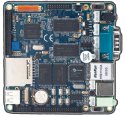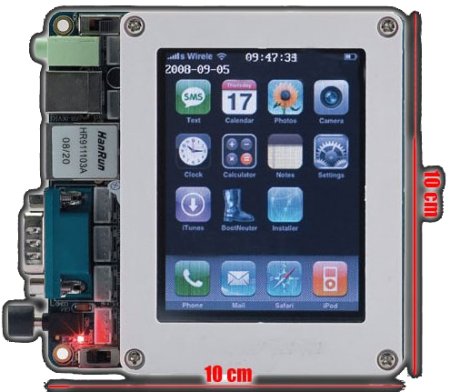ARM9 development kit runs Linux
Dec 17, 2008 — by Eric Brown — from the LinuxDevices Archive — 39 views Hiteg announced a Linux-ready, hardware/software development kit for Samsung's ARM9-based S3C2440 microprocessor. The 100mm-square Mini2440 board features the workhorse S3C2440 processor clocked to 533MHz, and targets embedded development training applications, industrial control equipment, and consumer… electronics devices like PDA devices and GPS navigators.
Hiteg announced a Linux-ready, hardware/software development kit for Samsung's ARM9-based S3C2440 microprocessor. The 100mm-square Mini2440 board features the workhorse S3C2440 processor clocked to 533MHz, and targets embedded development training applications, industrial control equipment, and consumer… electronics devices like PDA devices and GPS navigators.
(Click for larger view of the Mini2440)
Chinese embedded ARM vendor Hiteg offers a variety of development boards and processor modules based on the Samsung S3C2440 and lower-power S3C2410 processors. The boards are typically available with software development kits (SDKs) for Linux 2.6 and Windows CE 5.0 (more details on the SDKs below).
The Mini2440 appears to be Hiteg's smallest S3C2440 development kit to date. Measuring 3.9 by 3.9 inches (100 x 100mm), the AT2440 is a four-layer board that clocks the Samsung S3C2440's ARM920T RISC core at 400MHz (dominant frequency) and 533MHz (peak frequency). Launched in 2003, the widely used S3C2440 system-on-chip (SoC) primarily targets handheld devices such as smartphones and PDAs. The SoC integrates 16KB each of instruction and data cache, 4KB RAM, a NAND flash boot loader, power management functions, an interrupt controller, and an external memory controller (see block diagram)

Mini2440 with LCD
(Click to enlarge)
The Mini2440 comes standard with 64MB each of SDRAM and NAND flash, expandable via an SD card slot, along with 2MB of NOR flash. The board has camera and LCD interfaces, and can be ordered with a built-in 3.5-inch QVGA (320×240) module or external 7-inch display.
The Mini2440's complement of PC-style I/O includes Ethernet, USB host and slave ports, and three serial connections. Available options include a WiFi module, and CMOS and USB camera options. The Mini2440 board offers a “stable CPU power source chip and reset system,” says Hiteg.
Specifications listed for the Mini2440 include:
- Processor — Samsung S3C2440 (ARM920T core) clocked at up to 533MHz
- Memory — 64MB SDRAM (up to 100MHz)
- Flash — 64MB NAND flash; 2MB NOR flash
- Flash expansion — 1 x SD card interface
- Display — LCD controller with four-wire resistive touchscreen interface; optional 3.5- or 7-inch LCD displays
- Networking — 1 x 10/100 Ethernet RJ-45 interface (DM9000 chip)
- WiFi — optional WiFi module
- USB — 1 x USB Host; 1 x USB Slave (B-type interface)
- Serial — 3 x serial ports
- Audio — 1 x stereo audio output interface; 1 x mic interface
- Camera — 1 x 20-pin (2.0mm space) camera interface; optional CMOS or USB cameras
- Other I/O:
- 1 x 10-pin (2.0mm space) JTAG interface
- 4 x user LEDs
- 6 x user buttons
- 1 x PWM control buzzer
- 1 x adjustable resistance, for AD conversion test
- 1 x I2C bus AT24C08 chip, for I2C bus test
- 1 x 34-pin 2.0mm GPIO interface
- 1 x 40-pin 2.0mm system bus interface
- Power — RTC battery; power supply interface
- Clock — internal real-time clock and 12Mhz passive crystal system clock source
- Dimensions — 3.9 x 3.9 inches (100 x 100mm)
- Operating system — Linux 2.6.13; WindowsCE.NET 5.0
Available SDKs
The Mini2440 software development kit (SDK) includes the following components, says Hiteg:
- ADS1.2 development environment
- H-JTAG burning and debugging tool
- SJF2440 flash burning tool for Windows
- Jflash-2440 flash burning tool for Linux (source code provided)
- Serial tools CRT, dnw
- Bmp2t (picture transformer)
- USB driver for Windows XP/2000
- Vivi bootloader for Linux (source code provided)
- Test programs (source code provided)
- WinCE BSP and example project file
The Linux version of the SDK also offers additional Linux development tools and Linux 2.6.13 kernel source code, as well as Qtopia and “embedded browser” source code, says Hiteg. Components include:
- arm-linux-gcc-3.3.2 used for compiling Qtopia
- arm-linux-gcc-3.4.1 used for compiling kernel
- arm-linux-gcc-2.95.3 used for compiling Vivi
- Mkyaffsimage YAFFS filesystem image maker
- Drivers — DM9000, TFT LCD, audio card, touchscreen, SD card, RTC, expansion serial port, USB camera, USB mouse, keyboard, U-disk
Availability
The Mini2440 development board is available now for 150 Euros (about $211 US), while the 3.5-inch LCD version costs 200 Euros ($281). The 7-inch LCD version costs 280 Euros ($394), or 330 Euros ($464) when also equipped with a WiFi module and CMOS camera. More information may be found here.
This article was originally published on LinuxDevices.com and has been donated to the open source community by QuinStreet Inc. Please visit LinuxToday.com for up-to-date news and articles about Linux and open source.